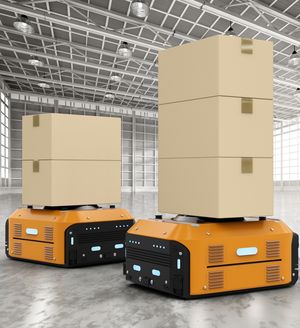KANBrief 4/17

The growing availability of affordable communication technologies also puts the smart factory within reach of medium-sized companies. Manufacturers face the challenge of meeting the increasingly differentiated wishes of their customers whilst at the same time manufacturing their products in greater quantities, faster and at lower cost. This is their only way of keeping their businesses viable in the face of growing competition.
In recent years, cheaper robot technology and electronic storage technology and affordable powerful processors have all become generally available. The expansion of the broadband network in particular enables new technologies to be used. In a range of sectors, the opportunities available to companies are becoming more and more diverse.
In industry 4.0 solutions, control systems receive input signals generated by sensors, process these signals, and exchange information with other systems. Based upon the data received, the available resources, i.e. unfinished and finished parts and the available operating personnel, are managed and requested by the various decentralized units (machines). The machines consequently organize themselves, according to a defined and programmed set of rules.
Connection to the Internet or the use of one or even multiple robots constitutes a conventional automation solution, and cannot of itself be termed an example of an Industry 4.0 application or a smart factory. Only when the number of sequentially operating robots is increased and they are able to organize their mutual cooperation themselves does conventional automation become an Industry 4.0 solution, and ultimately a smart factory.
Industry 4.0 in practice
Three sequentially operating robots are used in the fully automated manufacture of hunting knives (see image page 9). The robots have the functions of feed magazine, knife spine machining, two-sided grinding of the main edge, sharpening, stropping, drying, camera-based quality control, and return to a magazine. Despite the comprehensive functions assumed by the robots, description as Industry 4.0 was justified only once automated guided vehicles (AGVs) were integrated into the arrangement. The AGVs assume responsibility for loading magazine baskets containing the unfinished and finished material into the magazine system, and retrieving them again. The first robot in the chain is responsible for controlling the magazine system. It interacts with production installations operating in parallel, exchanges information with them, and signals its requirements to the AGVs. Besides requesting transport of the unfinished and finished parts, the machine automatically signals the need for maintenance and operating personnel. Based upon the set of rules programmed in advance, the machines themselves determine the timing and quantities of requests for resources.
The second example of an Industry 4.0 application is the organization of maintenance personnel by the global networking of machines, which exchange information fully automatically on machine states and transmit requests for personnel and replacement parts as needed. Strategies for preventive maintenance thus become increasingly important: the machines in the different countries communicate with each other over a global network and exchange information on their pending maintenance tasks. As a function of the urgency and scale of the maintenance task, the service engineers at the machine manufacturer's head office are informed and supplied with data from the machine. The machines thus assume, at a global level, the task of organizing the maintenance personnel. Service tasks are completed much more efficiently as a result, which ultimately reduces the machine down times.
We cannot afford to ignore Industry 4.0
Implementation of Industry 4.0 solutions often requires changes in production and value adding processes across entire companies. These changes represent a major challenge for companies of any size, but are often unavoidable if a company is to remain competitive on the world market. Companies therefore need to develop strategies at an early stage for successfully incorporating the new opportunities presented by digitalization into their own activities.
Dr. Andreas Groß
Tobias Rath
Berger Gruppe